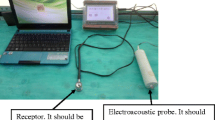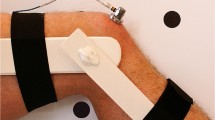Summary
A non-invasive acoustical system was developed for the measurement of transmission properties of acoustic waves in the hip joints. The instrumentation consisted of three sub-systems. An excitation system employed a vibratory force at the sacrum of the test subjects. A transduction system included a pair of identical microphones installed in the tubes of two stethoscopes, which were placed at the greater trochanters on both sides for picking up the acoustical signals transmitted across the hip joints. The data acquisition and analysis system was a portable signal analyzer with a program of dual channel digital filter for measuring the power of acoustical signal in 1/3-octave frequency bands. 27 normal adults, 20 normal pre-school children and 40 normal neonates were randomly selected for testing. Coherence function (CF) and discrepancy (D) was measured during the testing. Results from the three groups showed that there was a high coherence of the signals (CF>0.9) and a small discrepancy (D<3 dB) between bilateral hips in the frequency range of 200–315 Hz. For normal neonates, there was a wider frequency range of 160–315 Hz in which the acoustical signals maintained a high coherence (CF>0.93) and a smaller discrepancy (D<2 dB) was observed. This study showed that the development of the acoustical technique provided a practical method with objective parameters. The results obtained in this study can offer a baseline for further investigation of hip disorders particularly those related to structural abnormalities of the hip.
Similar content being viewed by others
References
Mollan R A B, McCullagh G C, Wilson A. Critical appraisal of auscultation of human joints. Clin Orthop Related Research, 1982,170:231
Kernohan W G, Beverland D E, McCoy G Fet al. The diagnostic potential of vibration arthrography. Clin Orthop Related Research, 1986,210:106
Richardson J B, Foo C K, Stone M Het al. Attenuation of sound transmission in congenital dislocation of the hip. J Bone Joint Surg, 1987,69(B):850
Stone M H, Richardson J B, Bennet G C. Another clinical test for congenital dislocation of the hip. Lancet, 1987,8359:954
File P, Wood J P, Kreplick L W. Diagnosis of hip fracture by the auscultatory percussion technique. Am J Emerg Med, 1998,16(2):73
Siffert R S, Kaufman J J. Acoustic assessment of fracture healing. Capabilities and limitations of “a lost art”. Am J Orthop, 1996,25(9):614
Peylan A. Direct auscultation of the joint. Rheumatism, 1953,9:77
Saha S, Lakes R S. The effect of soft tissue on wave propagation and vibration tests for determining the in vivo properties of bone. J Biomech, 1977,10:393
Author information
Authors and Affiliations
Rights and permissions
About this article
Cite this article
Huang, X., Kwong, K. & Cheng, J. The development and clinical application of acoustical technique in hip joint. Current Medical Science 22, 362–366 (2002). https://doi.org/10.1007/BF02896787
Received:
Published:
Issue Date:
DOI: https://doi.org/10.1007/BF02896787




